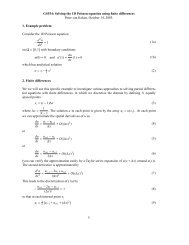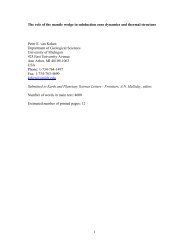Quantitative paleoenvironmental and paleoclimatic reconstruction ...
Quantitative paleoenvironmental and paleoclimatic reconstruction ...
Quantitative paleoenvironmental and paleoclimatic reconstruction ...
Create successful ePaper yourself
Turn your PDF publications into a flip-book with our unique Google optimized e-Paper software.
ARTICLE IN PRESS<br />
N.D. Sheldon, N.J. Tabor / Earth-Science Reviews xxx (2009) xxx–xxx<br />
23<br />
The fractionation of 16 O <strong>and</strong> 18 O among the reactants <strong>and</strong> products<br />
is described by the alpha value (α):<br />
18 α mineral =<br />
18 O mineral<br />
16 O mineral<br />
18 O H2 O<br />
16 O H2 O<br />
ð45Þ<br />
where 18 α is the oxygen isotope fractionation factor. The hydrogen <strong>and</strong><br />
carbon isotope fractionation factors are noted by D α <strong>and</strong> 18 α, respectively.<br />
α values for isotope exchange reactions are very small,<br />
which indicates that, in the absence of a more energetic reaction such<br />
as dissolution <strong>and</strong> precipitation, isotope exchange will not occur. That<br />
is, the isotope composition of a mineral is stable, <strong>and</strong> will remain<br />
unchanged, after it has formed. Fractionation of 18 O <strong>and</strong> 16 O between a<br />
mineral <strong>and</strong> water can vary, but changes in α are principally related to<br />
the temperature of reaction such that:<br />
10 3 lnα mineral−H2 O = A T 2 + B T + C ð46Þ<br />
where A, B, <strong>and</strong> C are constants which describe the behavior of an<br />
isotope for a specific mineral-water system, <strong>and</strong> T is temperature in K.<br />
Note, however, that the quantity B/T does not appear in many isotope<br />
fractionation equations. A list of fractionation equations for common<br />
pedogenic minerals is given in Table 5.<br />
Measurement of the isotope composition is usually reported with<br />
respect to the difference between the measured 18 O/ 16 O value of the<br />
sample with respect to the measured 18 O/ 16 O value of a st<strong>and</strong>ard.<br />
These reported values, called δ (“delta”) values, are calculated as:<br />
ð heavy X sample<br />
δX = light X sample<br />
× 1000 ð47Þ<br />
1Þ<br />
− heavy X st<strong>and</strong>ard<br />
light X st<strong>and</strong>ard<br />
where X is the element under consideration (C or O for example), heavy<br />
<strong>and</strong> light refer to the concentration of heavy <strong>and</strong> light isotopes, respectively,<br />
of element X in the sample <strong>and</strong> st<strong>and</strong>ard. δ values are<br />
reported in per-mil units (parts per thous<strong>and</strong>), which is denoted by<br />
the symbol, “‰”. Conventional presentation of δ values are δD for<br />
hydrogen, δ 13 C for carbon <strong>and</strong> δ 18 O for oxygen. The st<strong>and</strong>ard that is<br />
used for reporting δD <strong>and</strong> δ 18 O values is St<strong>and</strong>ard Mean Ocean Water<br />
(SMOW), whereas the st<strong>and</strong>ard used for reporting δ 13 C values is<br />
PeeDee Belemnite. Therefore both SMOW <strong>and</strong> PDB have δ values that<br />
are defined as 0‰ when referenced with respect to themselves.<br />
7.1.2. Stable isotope fractionation factors of common pedogenic minerals<br />
Asignificant amount of research has focused upon measurement <strong>and</strong><br />
determination of stable isotope fractionation factors (see reviews by<br />
Hoefs, 1997; Valley et al., 1986; Savin <strong>and</strong> Lee, 1988; Chacko et al., 2001;<br />
Sharp, 2007). Table 5 presents the stable isotope fractionation factors<br />
(values of 10 3 lnα) of common soil-forming minerals, as determined<br />
from laboratory syntheses, isotope exchange reactions <strong>and</strong> natural<br />
experiments. At temperatures that reflect soil formation in the presence<br />
of liquid water (~0–30 °C; Yapp, 2001a,b; Tabor <strong>and</strong> Montañez, 2005),<br />
the majority of mineral-water oxygen isotope fractionation factors<br />
(10 3 ln 18 α) have positive values, which indicates that 18 O is enriched in<br />
the mineral product (Table 5; Fig.14A). Carbonates <strong>and</strong> silicates have the<br />
largest (~25–35) <strong>and</strong> Fe(III)-oxides the smallest (~0–15) 10 3 ln 18 α<br />
values, <strong>and</strong> Al- <strong>and</strong> Mn-oxides have intermediate values. In addition,<br />
10 3 ln 18 α values decrease with higher temperatures for all minerals<br />
considered herein. Minerals with little or no ionic substitution, such as<br />
low-Mg calcite <strong>and</strong> kaolinite (Al 2 Si 2 O 5 (OH) 4 ) have relatively invariant<br />
10 3 ln 18 α values under isothermal conditions. Mineral groups that<br />
permit a great deal of metal-cation substitution, such as 2:1 phyllosilicate<br />
minerals, result in variable 10 3 ln 18 α values under isothermal<br />
conditions (Savin <strong>and</strong> Lee, 1988). For example, Tabor <strong>and</strong> Montañez<br />
(2005) reported the chemistry of smectites from Permian–Pennsylvanian-age<br />
paleosol profiles that correspond to differences in isothermal<br />
10 3 ln 18 α values N1‰ among samples, whereas Koster <strong>and</strong> others (1999)<br />
determined that nontronite (Na 0.3 Fe 3+ 2(Si,Al) 4 O 10 (OH) 2 ) 10 3 ln 18 α<br />
values are ~4‰ lower than Fe-rich 10 3 ln 18 α values. This highlights the<br />
importance of accurate mineralogical <strong>and</strong> chemical characterization of<br />
pedogenic minerals in order to interpret appropriately the meaning of<br />
their δ 18 Ovalues.<br />
All mineral-H 2 O hydrogen isotope fractionation factors (10 3 ln D α;<br />
Table 5; Fig. 14B) considered herein have negative values, indicating<br />
that 1 H is enriched in the mineral product. Goethite has the most<br />
negative (~−100), whereas gibbsite has the most positive (~− 5),<br />
10 3 ln D α values, <strong>and</strong> phyllosilicates have intermediate values. Within<br />
analytical uncertainty, goethite <strong>and</strong> gibbsite 10 3 ln D α values do not<br />
Table 5<br />
Light stable isotope fractionation equations for common soil-formed minerals.<br />
Reaction 10 3 ln 18 α 10 3 ln D α 10 3 ln 13 α Reference<br />
H 2 O(l)–H 2 O(v) 1.137⁎10 6 / T 2 −0.4156 ⁎ 28.844⁎10 6 /T 2 −76.248⁎<br />
Majoube, 1971<br />
10 3 /T−2.0667<br />
10 3 /T+52.612<br />
Calcite-H 2 O 2.78 ⁎10 6 /T 2 −2.89 –2.988⁎10 6 /T 2 +7.6663⁎10 3 /T−2.4612 (O'Neil et al., 1969; Kim <strong>and</strong><br />
O'Neil, 1997)<br />
Calcite-CO 2 18.03 ⁎103 / T−32.42<br />
Siderite-H 2 O 3.13⁎10 6 /T 2 − 3.50 Carothers et al. (1988)<br />
Siderite-CO 2 See Fig. 17<br />
Goethite-H 2 O 1.63⁎10 6 /T 2 −12.3 (Yapp, 1990; Yapp, 1987a,b; Bao <strong>and</strong><br />
Koch, 1999; Muller, 1995)<br />
1.907⁎10 3 /T−8.004 −99.8<br />
2.76⁎10 6 / T 2 −23.7<br />
Hematite-H 2 O 1.63⁎10 6 /T 2 −12.3 (Yapp, 1990; Clayton <strong>and</strong> Epstein, 1961;<br />
Bao <strong>and</strong> Koch, 1999)<br />
0.413⁎10 6 /T 2 −2.56<br />
0.542⁎10 6 /T 2 −5.221<br />
0.733⁎10 6 /T 2 − 6.194<br />
Gibbsite-H 2 O 2.04⁎10 6 /T 2 − (Vitali et al., 2000, 2001)<br />
3.61⁎10 3 /T+3.65 − 5.1<br />
Boehmite-H 2 O 2.11⁎10 6 /T 2 −4.4 XXX Bird et al. (1992)<br />
Kaolinite-H 2 O 2.76⁎10 6 / T 2 −6.75 − 2.2⁎10 6 / T 2 −7.7 Sheppard <strong>and</strong> Gilg (1996)<br />
Smectite-H 2 O 2.60 ⁎10 6 /T 2 −4.28<br />
Sum of metal-oxygen<br />
bonds<br />
−2.2⁎10 6 /T 2 − 7.7 +<br />
(2⁎Al− 4⁎Mg− 68 ⁎Fe)<br />
(Delgado <strong>and</strong> Reyes, 1996; Savin <strong>and</strong> Lee, 1988;<br />
Sheppard <strong>and</strong> Gilg, 1996)<br />
Illite/smectite-H 2 O<br />
−19.6⁎10 3 /T+25 (0–120 °C)<br />
−45.3 ⁎10 3 /T+94.7 (0–150 °C)<br />
(Yeh, 1980; Capuano, 1992; Hyeong <strong>and</strong><br />
Capuano, 2004)<br />
Please cite this article as: Sheldon, N.D., Tabor, N.J., <strong>Quantitative</strong> <strong>paleoenvironmental</strong> <strong>and</strong> <strong>paleoclimatic</strong> <strong>reconstruction</strong> using paleosols, Earth-<br />
Science Reviews (2009), doi:10.1016/j.earscirev.2009.03.004















